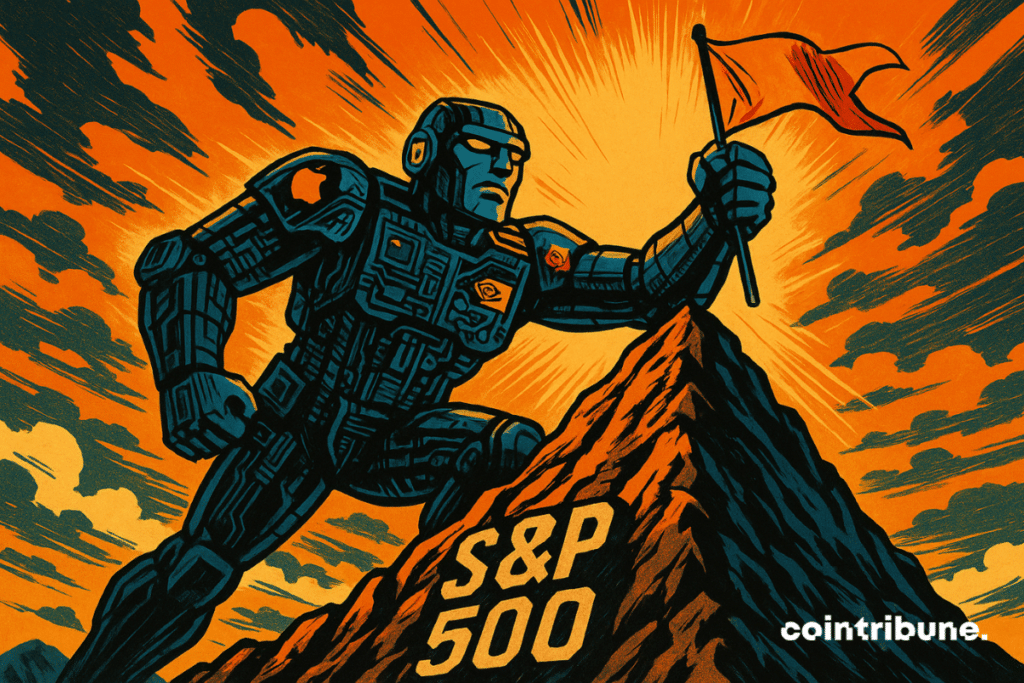S&P 500 Surges Despite Warning Signs On Economy
Driven by an unexpected easing in the Middle East and a resurgence of stock market optimism, the S&P 500 closed this Thursday at 6,141.02 points, nearing its historical high. Up 0.8 %, the iconic index marks a clear rebound since its April low, despite persistent uncertainties over trade tariffs and regional stability.

In Brief
- The S&P 500 reaches 6,141.02 points, approaching a historic record after a 0.8 % gain in a single day.
- This spectacular rebound comes after a ceasefire between Israel and Iran, reducing tensions in the Middle East.
- In two months, the capitalization of the U.S. markets surged by nearly 10 trillion dollars.
- Despite market enthusiasm, the U.S. economy shows clear signs of slowing down.
A geopolitical and trade respite unlocking the markets
The immediate trigger of this new stock market surge is to be found in the geopolitical de-escalation in the Middle East, with the conclusion of a ceasefire between Israel and Iran and the fall in oil prices, ending nearly two weeks of armed tensions.
This return to calm acted as a soothing signal for the markets, which had long been weighed down by fears of a large-scale energy conflict. At the same time, investors seem to be betting on a moderate scenario regarding U.S. trade policy.
Jay Woods, chief strategist at Freedom Capital Markets, indicates that “the market is calling the bluff on Trump’s tariff threats.” For him, the U.S. president will eventually give up his most severe measures.
Here are the key facts illustrating this shift in sentiment :
- The S&P 500 jumped 0.8% on Thursday to reach 6,141.02 points, flirting with its historical record ;
- A recovery of more than 23 % since the April lows, almost entirely erasing losses linked to recession fears ;
- Since April 2 (the date when Trump relaunched the trade war), the index has gained 8.3% ;
- Markets are priced for an optimistic scenario, betting on the postponement or mitigation of tariffs ;
- 50 % tariffs on European imports are suspended until July 9, while the trade truce with China remains in place until mid-August.
This trade and geopolitical respite, however, rests only on temporary factors. No concrete progress has yet been recorded in negotiations with the European Union or China.
Volatility could thus quickly return if geopolitical tensions resumed or if tariff threats became effective. For now, investors favor a positive reading of on-chain signals… willing to overlook short-term risks.
The resilience of companies and the tech comeback
While geopolitical relief allowed an immediate rebound, it is the strength of corporate results and the performance of the technology sector that add substance to this rally.
First quarter results generally exceeded expectations, despite warnings related to an uncertain tariff environment. Heavyweights such as Nvidia, Microsoft, Meta, Walmart, Goldman Sachs, and JPMorgan Chase delivered solid performances, providing a fundamental base for index gains.
“The tech and artificial intelligence theme’s comeback is setting the tone for the market after months focused on international trade,” analyzes Keith Lerner, co-director of investments at Truist Advisory Services.
Euphoria particularly focused on some mid-cap tech stocks, such as Microchip Technology and Seagate Technology, which have doubled in the stock market since April 8. This appetite for growth stocks signals a return of risk appetite, boosted by short-term macroeconomic outlooks deemed more favorable.
Consequently, several major investment banks such as Deutsche Bank, Barclays, Goldman Sachs, and Yardeni Research have raised their targets for the S&P 500 this year. For Brian Belski of BMO, the broadening sector performance and stabilization of reactions to political announcements outline a more constructive second half. He recently raised his annual target for the index to 6,700 points, up from 6,100 previously.
However, this bullish momentum does not erase all warning signs. The U.S. economy shows several signs of slowdown: industrial production has declined twice in three months, retail sales fell in May, notably in automobiles, and job creation is slowing. Added to that is a drop in manufacturing activity and imports falling to their lowest level in 16 years.
Some strategists at JPMorgan warn of a summer risk combining price pressures and weak growth. In this context, current valuations, already high, could lack support if the economic environment hardens with the return of Trump’s tariffs.
Maximize your Cointribune experience with our "Read to Earn" program! For every article you read, earn points and access exclusive rewards. Sign up now and start earning benefits.
Diplômé de Sciences Po Toulouse et titulaire d'une certification consultant blockchain délivrée par Alyra, j'ai rejoint l'aventure Cointribune en 2019. Convaincu du potentiel de la blockchain pour transformer de nombreux secteurs de l'économie, j'ai pris l'engagement de sensibiliser et d'informer le grand public sur cet écosystème en constante évolution. Mon objectif est de permettre à chacun de mieux comprendre la blockchain et de saisir les opportunités qu'elle offre. Je m'efforce chaque jour de fournir une analyse objective de l'actualité, de décrypter les tendances du marché, de relayer les dernières innovations technologiques et de mettre en perspective les enjeux économiques et sociétaux de cette révolution en marche.
The views, thoughts, and opinions expressed in this article belong solely to the author, and should not be taken as investment advice. Do your own research before taking any investment decisions.